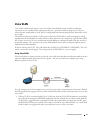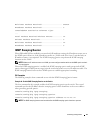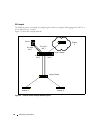
40 Switching Configuration
IGMP Snooping
This section describes the Internet Group Management Protocol (IGMP) Snooping feature. IGMP
Snooping enables the switch to monitor IGMP transactions between hosts and routers. It can help
conserve bandwidth by allowing the switch to forward IP multicast traffic only to connected hosts that
request multicast traffic.
If you enable IGMP Snooping on the switch to listen to IGMP traffic, you do not need to enable IGMP, a
layer 3 multicast protocol. IGMP Snooping is a layer 2 feature that allows the switch to dynamically add
or remove ports from IP multicast groups by listening to IGMP join and leave requests. If you use the
switch as a multicast router that can route multicast traffic between VLAN routing interfaces, you must
enable a multicast routing protocol on the switch, such as PIM-SM. In this case, you can enable both
IGMP and IGMP Snooping so that the switch routes IGMP traffic between VLANs and examines the
IGMP packets for join and leave information. For information about configuring the PowerConnect 6200
Series switch as a mutlicast router that also performs IGMP snooping, see "Multicast Routing and IGMP
Snooping" on page 157.
IGMP snooping
can be enabled per VLAN.
The IGMP feature on the PowerConnect 6200 Series switches
uses IGMPv3 by default.
CLI Examples
In this example, the PowerConnect 6200 Series switch is a L2 switch with one non-default VLAN, VLAN
100. The three hosts are connected to ports that are members of VLAN 100, and IGMP snooping is
enabled on VLAN 100. Port 1/g20 connects the switch to the L3 multicast router and is also a member of
VLAN 100.
Figure 3-2. Switch with IGMP Snooping
`
1/g5
1/g20
Host A
Multicast Router
Video Server
PowerConnect Switch
`
`
1/g10
1/g15
Host B
Host C


















